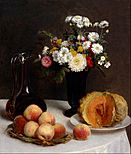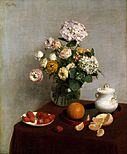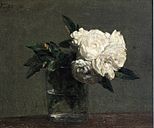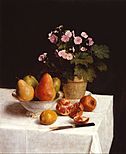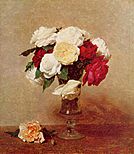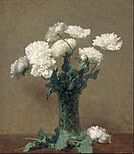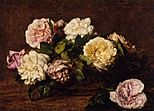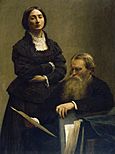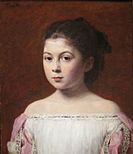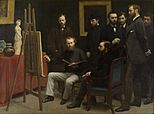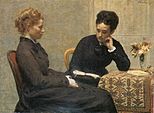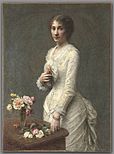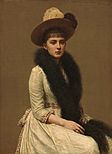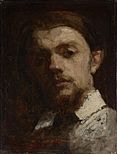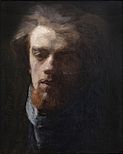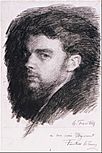Henri Fantin-Latour facts for kids
Quick facts for kids
Henri Fantin-Latour
|
|
|---|---|
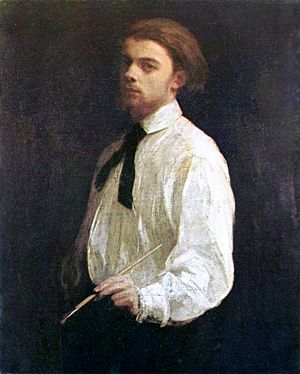
Self-portrait (1859), Museum of Grenoble
|
|
| Born | 14 January 1836 Grenoble, France
|
| Died | 25 August 1904 (aged 68) Buré, France
|
| Resting place | Cimetière du Montparnasse |
| Nationality | French |
| Education | École des Beaux-Arts |
| Movement | Realism, symbolism |
| Spouse(s) | Victoria Dubourg |
Henri Fantin-Latour (born January 14, 1836 – died August 25, 1904) was a French painter. He was also a lithographer, which means he made prints using a special stone or metal plate. He is most famous for his beautiful paintings of flowers. He also painted group portraits of artists and writers in Paris.
Contents
Fantin-Latour's Early Life
Henri Fantin-Latour was born in Grenoble, France. His father, Théodore Fantin-Latour, was also a painter. Henri learned drawing from his father first. In 1850, he moved to Paris. There, he joined a small art school. He studied with teachers like Louis-Alexandre Péron. He also learned from Horace Lecoq de Boisbaudran. This teacher had a special way of teaching. He taught students to paint and draw from memory.
In 1854, Henri entered the École des Beaux-Arts in Paris. This was a famous art school. He met other future artists there. These included Edgar Degas and Alphonse Legros. After art school, he spent a lot of time at the Musée du Louvre. He copied paintings by old master artists there. Fantin-Latour became friends with artists like James McNeill Whistler and Édouard Manet. These friends later became known for Impressionism. But Fantin-Latour's own painting style stayed more traditional.
In 1861, he spent a short time in the studio of Gustave Courbet. Courbet was a famous painter. Fantin-Latour painted many self-portraits early in his career. He used chalk, charcoal, and oil paint. One of his self-portraits was not accepted for an art show in 1859. But his painting La Liseuse was shown in 1861.
Fantin-Latour was part of a group called the Cénacle des Batignolles. This group formed around 1863. It was important because Impressionism started from it. Some people saw him as a link between this new art and older romantic painting.
In 1862, one of his still life paintings was shown in London. It was at the Royal Academy. This was the first of many shows for him there. He showed paintings in London almost every year. These paintings were very popular. He visited England several times. He found good success selling his art there.
Painting Flowers and Still Lifes
Fantin-Latour met American painter James MacNeill Whistler in 1858. Whistler encouraged him to visit London. Fantin-Latour stayed in London many times between 1859 and 1881. In the 1860s, he focused on still life paintings. These paintings became very important in his career. A "still life" is a painting of objects that do not move. These often include flowers or fruit.
Fantin-Latour became well-known in England for his flower and fruit paintings. At that time, French Impressionist art was not yet popular in England. People said his still life paintings were "practically unknown in France" during his life. Through Whistler, he met Francis Seymour Haden and Edwin Edwards. Edwards was an engraver. Fantin-Latour learned how to make engravings in London.
His choice to paint still lifes might seem surprising. This was because Impressionism was becoming popular. But painting still lifes was a special choice. In the 17th century, art schools ranked different types of paintings. Still life paintings of fruit or flowers were seen as less important. By focusing on them, Fantin-Latour went against the traditional rules of art. His English supporters, Edwin and Ruth Edwards, advised him. They told him to use simple vases and tables. This helped show his great skill in painting textures and colors.
Fantin-Latour's still life paintings were also very popular in the Netherlands. In 1889, one of his rose paintings sold for a lot of money in Amsterdam. Dutch art dealers sold his works until the 1930s. Many of his paintings are now in Dutch museums. These include the Rijksmuseum and the Kröller-Müller Museum.
His Unique Art Style
Fantin-Latour's first paintings were rejected from art shows in 1859. After that, he started showing his art with friends. These friends included Édouard Manet, Pierre-Auguste Renoir, and Claude Monet. In 1865, he wrote that artists needed to group together. This helped them get noticed.
In 1867, he joined the Japanese Jinglar Society. This group had nine members. They included painters like Carolus-Duran. They also included ceramists like Bracquemond. They met for dinners in a Japanese style.
Fantin-Latour made group portraits special again. These paintings were like big statements. Some famous ones are:
- Homage to Delacroix (1864)
- A Studio at Les Batignolles (1870), which honored Manet
- The Corner of the Table (1872), which honored poets like Paul Verlaine and Arthur Rimbaud
- Around the Piano (1885), which honored musicians
In A Studio at Les Batignolles, Manet is painting in the middle. He is surrounded by other important artists and writers. These include Pierre-Auguste Renoir, Emile Zola, and Claude Monet. This painting shows Fantin-Latour's connections. He was friends with the leading artists and writers of his time. It also shows how much he respected Manet.
Besides his realistic paintings, Fantin-Latour also made creative lithographs. These were inspired by classical music. In 1876, he saw a performance of Richard Wagner's Ring cycle. He found it very moving. Later, he made lithographs inspired by Wagner. These were published in a magazine called La revue wagnérienne. This helped him become known as an anti-naturalist painter. This meant he painted more from imagination than from real life.
In 1876, Fantin-Latour married Victoria Dubourg. She was also a painter. He spent his summers at his wife's family home in Buré, France. He died there on August 25, 1904. Like many painters, he used photography for his work. He was buried in the Cimetière du Montparnasse in Paris.
His Lasting Impact
His first big art show in the UK in 40 years happened in 2011. It was at the Bowes Museum. The Musée du Luxembourg had a show of his work in 2016–2017. It was called "À fleur de peau."
One of his paintings, A Basket of Roses, became famous in a different way. It was used as the cover for the band New Order's album Power, Corruption & Lies in 1983. The graphic designer Peter Saville chose it.
Gallery
- Flower paintings
- Other still lifes
-
Still Life with Mustard Pot (1860), National Gallery of Art
- Portraits and allegorical paintings
-
Mr. and Mrs. Edwards (1875), Tate Gallery
-
Édouard Manet (1867), Art Institute of Chicago
-
Dubourg Family (1878), Musée d'Orsay
-
La Lecture (1877), Musée des Beaux-Arts de Lyon
-
Portrait of Charlotte Dubourg (1882), Paris, musée d'Orsay
-
Sonia (1890), National Gallery of Art
- Self-portraits
Public collections
- Aberdeen Art Gallery (Scotland)
- Armand Hammer Museum of Art (California)
- Art Gallery of New South Wales (Sydney, Australia)
- Art Gallery of the University of Rochester (New York)
- Art Institute of Chicago
- Arthur Ross Gallery (University of Pennsylvania)
- Ashmolean Museum (University of Oxford)
- Birmingham Museums & Art Gallery (UK)
- Bristol Museum & Art Gallery (UK)
- Bowes Museum (County Durham, England)
- British Museum
- Carnegie Museum of Art (Pittsburgh, Pennsylvania)
- Clark Art Institute (Williamstown, Massachusetts)
- Cleveland Museum of Art
- Dallas Museum of Art
- Detroit Institute of Arts
- Dixon Gallery and Gardens (Tennessee)
- Fine Arts Museums of San Francisco
- Fitzwilliam Museum (University of Cambridge)
- Fondation Bemberg Museum (Toulouse, France)
- Foundation E.G. Bührle (Zürich)
- Hammer Museum
- Harvard University Art Museums
- Hermitage Museum
- Honolulu Museum of Art
- Indiana University Art Museum
- J. Paul Getty Museum
- Kröller-Müller Museum (Otterlo, Netherlands)
- Lady Lever Art Gallery (UK)
- La Piscine (Roubaix, France)
- Los Angeles County Museum of Art
- MacKenzie Art Gallery (Regina, Saskatchewan)
- Manchester City Art Gallery (UK)
- Metropolitan Museum of Art
- Montreal Museum of Fine Arts, (Canada)
- Museum of Grenoble (France)
- Museum of Modern Art
- Musée de Picardie (Amiens, France)
- Musée des Beaux-Arts de Bordeaux (France)
- Musée des Beaux-Arts de Lyon (France)
- Musée des beaux-arts de Pau (Pau, France)
- Musée des Beaux-Arts (Reims, France)
- Museum Geelvinck (Amsterdam, Netherlands)
- Musée des Beaux-Arts de Rouen (France)
- Musée d'Orsay (Paris)
- Musée du Louvre (Paris)
- Musée des Ursulines (Mâcon, France)
- Museo Nacional de Bellas Artes (Buenos Aires, Argentina)
- Museu Calouste Gulbenkian (Lisbon)
- Museum of Fine Arts, Boston
- National Gallery of Art (Washington D.C.)
- National Gallery of Canada
- National Gallery, London
- National Museum Cardiff
- Nelson-Atkins Museum of Art (Kansas City, Missouri)
- Norton Simon Museum (Pasadena, California)
- Old Jail Art Center (Albany, Texas)
- Philadelphia Museum of Art
- Rijksmuseum (Amsterdam)
- Saint Louis Art Museum
- San Diego Museum of Art
- Smart Museum of Art (University of Chicago)
- Tate Gallery (London)
- Thyssen-Bornemisza Museum
- Toledo Museum of Art (Ohio)
- Université de Liège Collections (Belgium)
- University of Michigan Museum of Art (Ann Arbor)
- Van Gogh Museum
- Victoria and Albert Museum
- Virginia Museum of Fine Arts
- Wadsworth Atheneum (Hartford)
- Winnipeg Art Gallery
See also
 In Spanish: Henri Fantin-Latour para niños
In Spanish: Henri Fantin-Latour para niños


